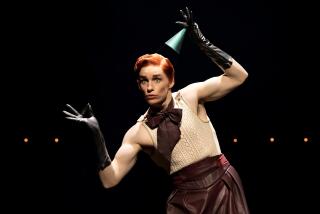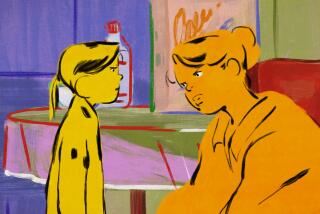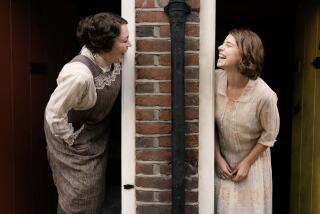Critic’s Notebook: Mary Poppins is popular without pandering
No, that’s not a UFO hovering over the Music Center. It happens to be Mary Poppins, who has glided back down to the Ahmanson Theatre on her miraculous umbrella for the return engagement of the relentlessly popular family musical based on the stories of P.L. Travers and the Walt Disney film.
Recently seen in pitched battle against some fictional bad guys at the opening ceremony of the London Olympics, Mary Poppins is never out of sight for long. What is the secret of her enduring charm? That is a question for a delightful little book, not a newspaper article. But permit me in the space I have to point out a tangy irony regarding the character’s appeal: For all her crowd-pleasing clout, this supernatural nanny panders to nobody, including those who are paying her modest salary.
Infinitely lovable Julie Andrews wasn’t the actress to reveal just how steely Travers’ creation can be, even in a less Disney-fied movie than the 1964 classic with Dick Van Dyke. Self-governing to a fault, the literary Mary Poppins has a willful streak and bold tongue that would get most domestics thrown out on the front steps without a pence of severance. But then she’s more than just a hired hand in the nursery. She’s a flying societal corrective, more radical in her perspective on the shortcomings of middle-class life than most parents reading her tales at bedtime to their little ones might comfortably suspect.
Watch her at the Ahmanson, in a confident, charismatic performance by Rachel Wallace, dismantle the faltering world around her only to remount it on more solid footing. No institution — be it the bank where Mr. Banks works or the home where his children run roughshod over their previous nannies and his wife frets over his impatient temper — is safe from her critical gaze.
Patriarchy, snobbery, the plight of the working class, even the financial system itself — Mary Poppins scans the full panoply of her society’s ails and finds one common theme: our forgotten common humanity. Like a good psychoanalyst, she doesn’t identify the misplaced emotion but provides instead, in her distantly nurturing way, an opportunity for her charges, young and old alike, to feel it.
Even language gets deconstructed by this human X-ray machine in the “Supercalifragilisticexpialidocious” number, which might have been written by the Swiss linguist Ferdinand de Saussure, whose work exposed the arbitrary relationship of sign and signifier. Or as Mary Poppins more playfully puts it: “And where do you think words came from in the first place? Somebody had to make them up.”
A post-structuralist Mary Poppins? The vaults of academic libraries are no doubt lined with dissertations on the subject.
Julian Fellowes’ book for this musical version tries to restore some of the character’s sharper edges. There’s something unyielding about this strange woman who flies into the lives of the Banks family on Cherry Tree Lane like a bird that chooses to grace you with its song but leaves once its intuitive melody has come to an end.
“How long will you stay?” young Jane asks after a glorious outing in the park, where statues sprang to life. “You won’t leave us, will you, Mary Poppins?” seemingly younger Michael wonders, never wanting the enchantment to end.
“I’ll stay until the wind changes,” Mary Poppins replies in words that could serve as the epigraph to the series of books recounting her adventures. Child psychologist Bruno Bettelheim taught us to become more attuned to the darker currents of fairy tales, and the “Mary Poppins” saga is one that speaks directly to the unconscious fears of loss that are a function of our helpless dependency at birth.
The Australian-born Travers, who came into her own in England, suffered the early death of her father, a tragedy that was compounded by her erratic, ill-equipped mother. If philosophy is born out of wonder, the wonder of children’s literature seems to be born out of something somberly philosophical.
Directed by Richard Eyre and co-directed and choreographed by Matthew Bourne, this musical strikes a compromise between Travers’ vision and the Disney movie. An effervescent sentimentality ensues when the cast is singing and dancing, but otherwise Mary Poppins is permitted to pursue her child-care duties without many touchy-feely flourishes.
When I first encountered this production in London, the bewitching protagonist spoke in almost robotic tones devoid of superficial affection. The American version has softened her nature. Yet if Mary Poppins’ heart is noticeably warmer, it’s still under the firm control of her cool mind.
This touring production isn’t quite as fresh as when it appeared at the Ahmanson in 2009. The staging has that jobbed-in feeling that makes it easy to envision a list in which cities get crossed out one by one by a burly roadie.
Still, the spectacle, featuring a few aeronautic effects that are sure to set loose stomach butterflies, is captivating enough to prevent most tykes from hollering out “Is it over yet?” as one young fellow did close to the end of what is undeniably an overlong show. It certainly helps that Wallace’s Mary Poppins and Nicolas Dromard’s Bert, the vivaciously dancing chimney sweep and street artist, are such excellent company.
All of this is predicated, of course, on Travers’ singular creation, that mystical nanny who’s still instructing us on how to live with more color and kite-flying. And who sagely reminds us that fictions needn’t be ingratiating to be embraced by generations.
More to Read
The biggest entertainment stories
Get our big stories about Hollywood, film, television, music, arts, culture and more right in your inbox as soon as they publish.
You may occasionally receive promotional content from the Los Angeles Times.







